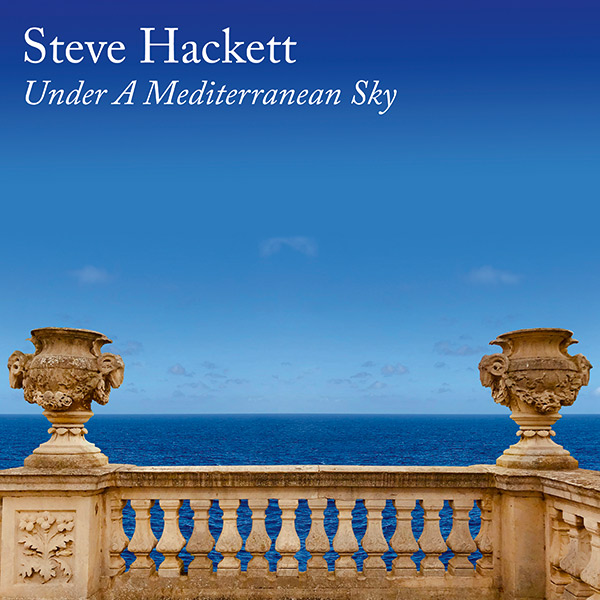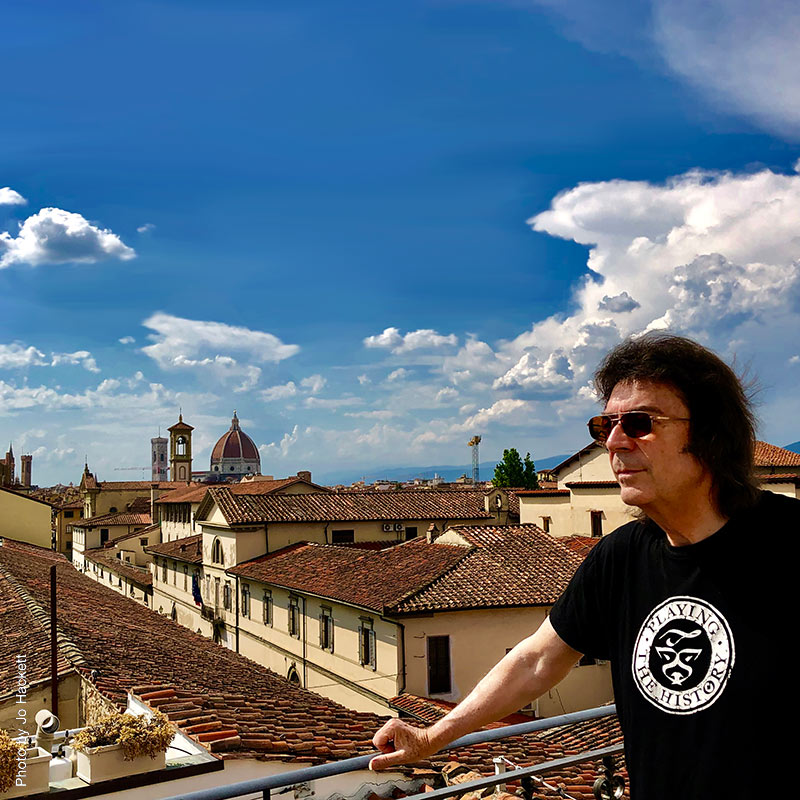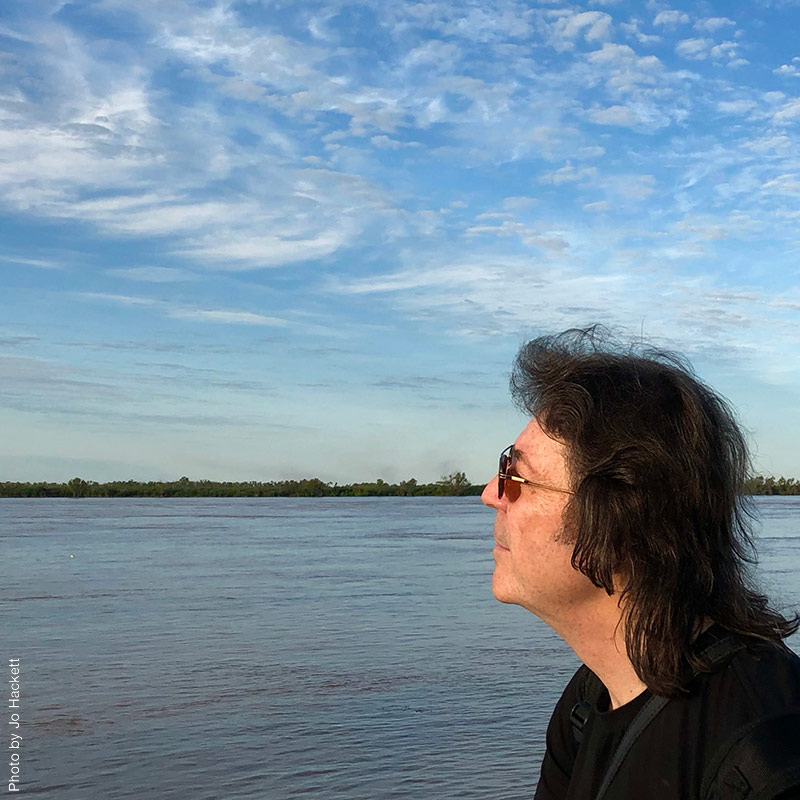- Artikel
- Lesezeit ca. 6 Minuten
Steve Hackett – Under A Mediterranean Sky – review
In 2021, Steve Hackett surprised us with another acoustic album. Andreas Lauer shares his thoughts for us.

It has taken a while, and the corona virus has accelerated things. Steve Hackett places the acoustic guitar in the centre of a studio album for the first time in almost fourteen years. Its predecessors were Tribute (2007), where Steve’s role was more as a performer than a composer, Metamorpheus (2005), and A Midsummer Night’s Dream (1997), both of which were orchestral albums with the guitar as a solo instrument, as well as Momentum (1988) and Bay Of Kings (1983). It is the latter two that the new release resembles most in the use of synthetic strings that are added to some of the tracks.
 Where Steve’s brother John Hackett added some relevant flute accents here and there back then, we now can hear many more “real” instruments. The intention of Bay Of Kings (another maritime title) was to showcase the whole range of sounds a guitar can make (the guitar as a little orchestra, as it were). This time stylistic variety is provided by the concept of a journey through the countries that border the Mediterranean – a journey inspired by Steve and Jo’s actual travels in recent years that they shared in words and images with their fans). Tracks that feature only the guitar more or less alternate with tracks in which other instruments join in; again, there are no vocals on this acoustic guitar album. Roger King is the co-author of all tracks with additional instruments except The Call Of The Sea. Jo Hackett has added the odd melody. Steve wrote only three songs on his own, and we also get to hear an arrangement of a piece written centuries ago (no, not by Steve), as we did on previous albums from composers such as Giuliani, Bach, Vivaldi and the composers from the Tribute album.
Where Steve’s brother John Hackett added some relevant flute accents here and there back then, we now can hear many more “real” instruments. The intention of Bay Of Kings (another maritime title) was to showcase the whole range of sounds a guitar can make (the guitar as a little orchestra, as it were). This time stylistic variety is provided by the concept of a journey through the countries that border the Mediterranean – a journey inspired by Steve and Jo’s actual travels in recent years that they shared in words and images with their fans). Tracks that feature only the guitar more or less alternate with tracks in which other instruments join in; again, there are no vocals on this acoustic guitar album. Roger King is the co-author of all tracks with additional instruments except The Call Of The Sea. Jo Hackett has added the odd melody. Steve wrote only three songs on his own, and we also get to hear an arrangement of a piece written centuries ago (no, not by Steve), as we did on previous albums from composers such as Giuliani, Bach, Vivaldi and the composers from the Tribute album.
Mdina (The Walled City)
The journey begins in Mdina, former capital of Malta, which is also called the Quiet or the Notable Town. Steve points out the walls that surround the town in the title. The walls are probably also the subject matter of the orchestral introduction in which sampled timpani and brass instruments as well as changing time signatures are the predominant elements. In this longest track on the album (8:45) the guitar comes in only after more than a minute with some rhapsodic virtuoso parts. The first half of the track fades out with cleverly arranged bells before the dramatic intro is reprised. It introduces the second half with its simple long-ranging melody in which guitar and orchestra alternate as well as complement each other.
Adriatic Blue
The album continues at the shores of the Adriatic in Croatia as seen on a concert trip with Djabe. Adriatic Blue, a piece for solo guitar, would not have been out of place on Bay Of Kings with its (pre-) baroque influences. As far as the songwriting and the playing is concerned it fits better on Momentum.
Sirocco
Steve has described this title as impressionist. It is dedicated to the sirocco, the hot desert wind that Steve encountered in Morocco, Egypt and Jordan. As in many other places on the album, the song is shaped by scales with augmented seconds that give it an Eastern, Oriental flair. Steve can also be heard playing the oud, a kind of Arabic lute, as befits the area of the song.
Joie De Vivre
Next up is a French chanson that could very well have been sung by Serge Gainsbourg. Syncopated verses are clad in a pre- and interlude with arpeggiated more complex chords.
The Memory Of Myth
We go East again and turn towards the myths of ancient Greece. The mysterious (listen to the string tremolo beginning at 1:41), literally dream-like music begins with an introduction on the (real) violin by Christine Townsend. Several times we believe this was the prelude to Imagining … but that, too, was but a dream, and the track vanishes like a soap bubble.
Scarlatti Sonata
Without more precise information we get to hear, in the approximate middle of the album, what probably is an arrangement of a composition by Domenico Scarlatti. Scarlatti was a contemporary of J. S. Bach and wrote 555 cembalo sonatas. Steve points out the trill technique (probably played on two strings instead of one) that he says he learned from one late Theo Cheng.
Casa Del Fauno
It was in a house in the famous town of Pompeii, which was buried by an eruption from Mount Vesuvius, that the sculpture of a faun was unearthed. This was the inspiration for this track. After a slow orchestral introduction in the manner of Rota or Barber the guitar comes in at 1:11, but the best is yet to come: John Hackett and Rob Townsend play their flutes together, and this is a really wonderful moment on the album!
The Dervish And The Djin
 The highlights follow each other quickly. As Steve notes, The Dervish And The Djin refer to the Persian culture (and the Persian empire extended across many areas that border the Mediterranean). Persia once also ruled in what is today Armenia and Azerbaijan. The countries are at war with each other, but Steve managed to enlist musicians from both countries for this track – and it is probably the most intense track on the album. Malik Mansurov (from Azerbaijan) plays the tar, an oriental long-necked lute (from 1:35) while the Armenian Arsen Petrosyan plays the doudouk, a wind instrument for which Peter Gabriel as well as Tony Banks wonderfully presented on albums of theirs. A lovely peace-promoting idea. With Rob Townsend on the alto saxophone it is the track that has the largest number of musicians. The dramatic concept is clear: From the dervish’s meditation, we may imagine, develops an increasingly intense dance that becomes dizzily ecstatic, particularly in the second half (the apparition of the spirit?) – Townsend’s saxophone is mixed in a way that reminds me of some of the spacy sounds by Nik Turner (Hawkwind). The end is, fortunately, not a fade-out, but an almost abrupt return to a standstill.
The highlights follow each other quickly. As Steve notes, The Dervish And The Djin refer to the Persian culture (and the Persian empire extended across many areas that border the Mediterranean). Persia once also ruled in what is today Armenia and Azerbaijan. The countries are at war with each other, but Steve managed to enlist musicians from both countries for this track – and it is probably the most intense track on the album. Malik Mansurov (from Azerbaijan) plays the tar, an oriental long-necked lute (from 1:35) while the Armenian Arsen Petrosyan plays the doudouk, a wind instrument for which Peter Gabriel as well as Tony Banks wonderfully presented on albums of theirs. A lovely peace-promoting idea. With Rob Townsend on the alto saxophone it is the track that has the largest number of musicians. The dramatic concept is clear: From the dervish’s meditation, we may imagine, develops an increasingly intense dance that becomes dizzily ecstatic, particularly in the second half (the apparition of the spirit?) – Townsend’s saxophone is mixed in a way that reminds me of some of the spacy sounds by Nik Turner (Hawkwind). The end is, fortunately, not a fade-out, but an almost abrupt return to a standstill.
Lorato
We leave the Mediterranean for a quick trip to Botswana in southern Africa. In Tswana, one of the languages spoken there, the word for love is lorato. Steve donated this song in 2016 for the book and album Harmony For Elephants; Anthony Phillips was also very involved with that album, and they both wrote a song together. This is a new version on a differently strung guitar. The track is some 20 seconds longer than in 2016 (it still is the shortest track on the album). Stylistically, this song-like piece is perhaps closest to Steve’s Midsummer Night’s Dream from 1997.
Andalusian Heart
It’s time to pay homage to Spain and its flamenco musicians. A strangely familiar melody accompanies Steve’s virtuoso guitar work, a melody played by Roger’s orchestra, Franck Avril on oboe and Christine Townsend who plays both viola and violin. The track savours this melody which is, in fact, the instrumental interlude from (spoiler alert) tuO yaW ysaE ehT gnikaT from Steve’s 1984 album that already looked far beyond the horizon as far as style and culture are concerned.
The Call Of The Sea
The last track is dedicated to the Mediterranean Sea itself, and it may seem medi-ocre in comparison to what we have heard before. It begins with solo guitar. As in several other places on the album Steve briefly cites other tracks of his in bits that resemble the acoustic sections of his rock concerts. It is quite an enjoyable pastime to work out from where you know this motive or that harmony. The last three-and-a-half minutes offer plain fare with simple ingredients in melody, rhythm and harmonic additions: guitar and string sounds.
If you love Steve’s acoustic albums this new release will not disappoint you. It also proves that good things can come out of the Covid-19 lockdown, too. Neither here nor on his preceding „electric“ albums will we find him breaking new ground, but very few of the very great composers have done that in their later lives. Our sinking hope that we might get another album like this again has surprisingly been fulfilled. Under A Mediterranean Sky takes its very own place in Steve’s oeuvre in terms of concept, style and instruments. As you listen to it repeatedly you will grow very fond of this album, and it will take you on a sensual trip to Mediterranean regions you may never have been to before.

